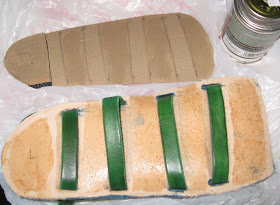I cut out 3/4-length pieces for each foot, plus extra pieces for a second layer at the heel.

First, I glued the heel layer to the sole layer of padding. I also marked where the sandal straps will go relative to the padding.

Since the straps are all supposed to be adjustable, they need to be able to slide across the sole, so I was careful to avoid putting any contact cement where the straps will be. I'm now ready to glue the padding to the upper sole. Note that the extra layer of padding at the heel will butt right up against the strap there.


The fabric side of the foam rubber did not glue well, so it required multiple coats of the contact cement before gluing to the other piece.
Also, once I had it glued together, there wasn't enough leather to form a good bond around the padding. I pulled it back apart, trimmed the padding to be narrower, and glued it back together.

Nailing the Soles
Since I had this romantic vision of shoemakers nailing shoes together, I wanted to try that myself. Finding the right type of nails turned out to be problematic, though, since normal people don't use shoemaker's nails. There are also quite a few different types of shoemaker's nails. The instructions I was following in the "Sandal Making" book just said "Sole Nails", which turns out to be not quite the right terminology.
I ended up getting "wire clinch nails" from Louis Birns. And of course, I needed to learn yet another measurement convention. It seems that for wire clinch nails, the sizes are noted as 4/8, 5/8, 6/8, 7/8, and 8/8, where 8/8 is a nail an inch long, and 4/8 is half an inch. The trick, though, is that the tip of the nail is meant to bend over when it strikes the anvil, thus locking the nail into the leather sole. So an 8/8 nail is meant to secure a sole that is just less than an inch thick.
I used 5/8 for the main sole and 7/8 for the heel. Here you can see that the nails on the sole poke through quite a bit and bend way over--they are too long for this thickness of sole. These nails would really mess up a nice hardwood floor.
 If you look closely you can see the U shape of the nails poking out from the soles--not the desired effect.
If you look closely you can see the U shape of the nails poking out from the soles--not the desired effect. Non-slip Soling
Non-slip SolingI got a sheet of SoleTech 3.5 soling material from Louis Birns. This is pretty thin rubbery material with a slight texture to make the soles less slippery.
Here are the SoleTech pieces I cut. I don't plan to have the rubber come up over the point of the shoes, so it is cut short at the toes.

I glued on the SoleTech with more contact cement. I also dyed the edges of the sandals blue and treated them with Lexol and carnauba creme as I did with the upper soles and straps.
Here are the finished sandals. Yay! I've finished my first pair!

Thoughts for Next Time
Nails: The 7/8 wire clinch nails I used around the heels worked fine, but the 5/8 nails I used for the much thinner sole section were too long. This caused them to form raised "U" shapes on the surface of the sole when they bent over, instead of having just the tip bending flat back into the sole.
Bottom sole surfacing: I had some trouble with having the SoleTech sheet peeling off the sandals, particularly where the nails stuck up from the leather sole, causing about a square centimeter of the SoleTech to not adhere well to the leather sole with the contact cement. I had to redo the sole piece for one sandal, partly because I had cut it a little small, and a couple of nails stuck out right at the edge, aggravating the peeling problem. The second time I cut the SoleTech piece a little larger than the sole, and I trimmed off the excess with a knife after gluing. That worked much better. I think trimming the rubber to the sole also helps avoid creating a place where the rubber can catch on something and be pulled off. Later, though, I plan to try some different soling materials. This SoleTech 3.5 is really too thin and fragile for the sandals I'm making, and it's wearing through much too quickly.
Cement: It also seemed that the contact cement wasn't strong enough (except for its smell!) for gluing the rubber to the leather, though it was fine for the leather-to-leather bond. One of the guys at the leather store suggested using multiple coats of the cement on each side before putting them together. I tried multiple coats later, and it helped (though at that later point I was also using the new Barge formula of Tandy's contact cement, which may have worked better, though it smelled even worse than the previous cement).
The Lure of Leather
This is the piece of thick "saddle skirting" leather I used for my soles. It was an entire side before I started cutting it, and it takes up most of my kitchen floor.

Once in a while I get way too much help! Both my younger daughter and Lacey think this is just the place to plop down for a bit...

And, of course, they want some sandals too!

No comments:
Post a Comment